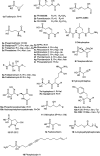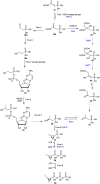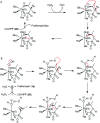The intriguing biology and chemistry of fosfomycin: the only marketed phosphonate antibiotic
- PMID: 35548698
- PMCID: PMC9088020
- DOI: 10.1039/c9ra08299a
The intriguing biology and chemistry of fosfomycin: the only marketed phosphonate antibiotic
Abstract
Recently infectious diseases caused by the increased emergence and rapid spread of drug-resistant bacterial isolates have been one of the main threats to global public health because of a marked surge in both morbidity and mortality. The only phosphonate antibiotic in the clinic, fosfomycin, is a small broad-spectrum molecule that effectively inhibits the initial step in peptidoglycan biosynthesis by blocking the enzyme, MurA in both Gram-positive and Gram-negative bacteria. As fosfomycin has a novel mechanism of action, low toxicity, a broad spectrum of antibacterial activity, excellent pharmacodynamic/pharmacokinetic properties, and good bioavailability, it has been approved for clinical use in the treatment of urinary tract bacterial infections in many countries for several decades. Furthermore, its potential use for difficult-to-treat bacterial infections has become promising, and fosfomycin has become an ideal candidate for the effective treatment of bacterial infections caused by multidrug-resistant isolates, especially in combination with other therapeutic drugs. Here we aim to present an overview of the biology and chemistry of fosfomycin including isolation and characterization, pharmacology, biosynthesis and chemical synthesis since its discovery in order to not only help scientists reassess the role of this exciting drug in fighting antibiotic resistance but also build the stage for discovering more novel phosphonate antibiotics in the future.
This journal is © The Royal Society of Chemistry.
Conflict of interest statement
There are no conflicts of interest to declare.
Figures









Similar articles
-
Molecular Mechanisms and Clinical Impact of Acquired and Intrinsic Fosfomycin Resistance.Antibiotics (Basel). 2013 Apr 16;2(2):217-36. doi: 10.3390/antibiotics2020217. Antibiotics (Basel). 2013. PMID: 27029300 Free PMC article. Review.
-
[Fosfomycin--its significance for treatment of diseases due to multidrug-resistant bacteria].Med Monatsschr Pharm. 2015 Jan;38(1):4-11. Med Monatsschr Pharm. 2015. PMID: 26349119 Review. German.
-
[Fosfomycin: past, present and future].Mikrobiyol Bul. 2010 Apr;44(2):311-21. Mikrobiyol Bul. 2010. PMID: 20549968 Review. Turkish.
-
Fosfomycin for the treatment of resistant gram-negative bacterial infections. Insights from the Society of Infectious Diseases Pharmacists.Pharmacotherapy. 2014 Aug;34(8):845-57. doi: 10.1002/phar.1434. Epub 2014 Apr 30. Pharmacotherapy. 2014. PMID: 24782335 Review.
-
Resistance to fosfomycin: Mechanisms, Frequency and Clinical Consequences.Int J Antimicrob Agents. 2019 Jan;53(1):22-28. doi: 10.1016/j.ijantimicag.2018.09.013. Epub 2018 Sep 27. Int J Antimicrob Agents. 2019. PMID: 30268576 Review.
Cited by
-
Biosynthesis of fosfomycin in pseudomonads reveals an unexpected enzymatic activity in the metallohydrolase superfamily.Proc Natl Acad Sci U S A. 2021 Jun 8;118(23):e2019863118. doi: 10.1073/pnas.2019863118. Proc Natl Acad Sci U S A. 2021. PMID: 34074759 Free PMC article.
-
Assessment of the Susceptibility of Clinical Gram-Negative and Gram-Positive Bacterial Strains to Fosfomycin and Significance of This Antibiotic in Infection Treatment.Pathogens. 2022 Nov 30;11(12):1441. doi: 10.3390/pathogens11121441. Pathogens. 2022. PMID: 36558775 Free PMC article.
-
In Vitro Susceptibility of Multi-Drug Resistant Klebsiellapneumoniae Strains Causing Nosocomial Infections to Fosfomycin. A Comparison of Determination Methods.Pathogens. 2021 Apr 23;10(5):512. doi: 10.3390/pathogens10050512. Pathogens. 2021. PMID: 33922754 Free PMC article.
-
Oxydifficidin, a potent Neisseria gonorrhoeae antibiotic due to DedA assisted uptake and ribosomal protein RplL sensitivity.bioRxiv [Preprint]. 2024 Sep 25:2024.05.27.596031. doi: 10.1101/2024.05.27.596031. bioRxiv. 2024. Update in: Elife. 2025 May 28;13:RP99281. doi: 10.7554/eLife.99281. PMID: 38854004 Free PMC article. Updated. Preprint.
-
Inhibition of MurA Enzyme from Escherichia coli and Staphylococcus aureus by Diterpenes from Lepechinia meyenii and Their Synthetic Analogs.Antibiotics (Basel). 2021 Dec 15;10(12):1535. doi: 10.3390/antibiotics10121535. Antibiotics (Basel). 2021. PMID: 34943747 Free PMC article.
References
-
- Freedman L. D. Doak G. Chem. Rev. 1957;57:479–523. doi: 10.1021/cr50015a003. - DOI
Publication types
LinkOut - more resources
Full Text Sources
Molecular Biology Databases
Research Materials

